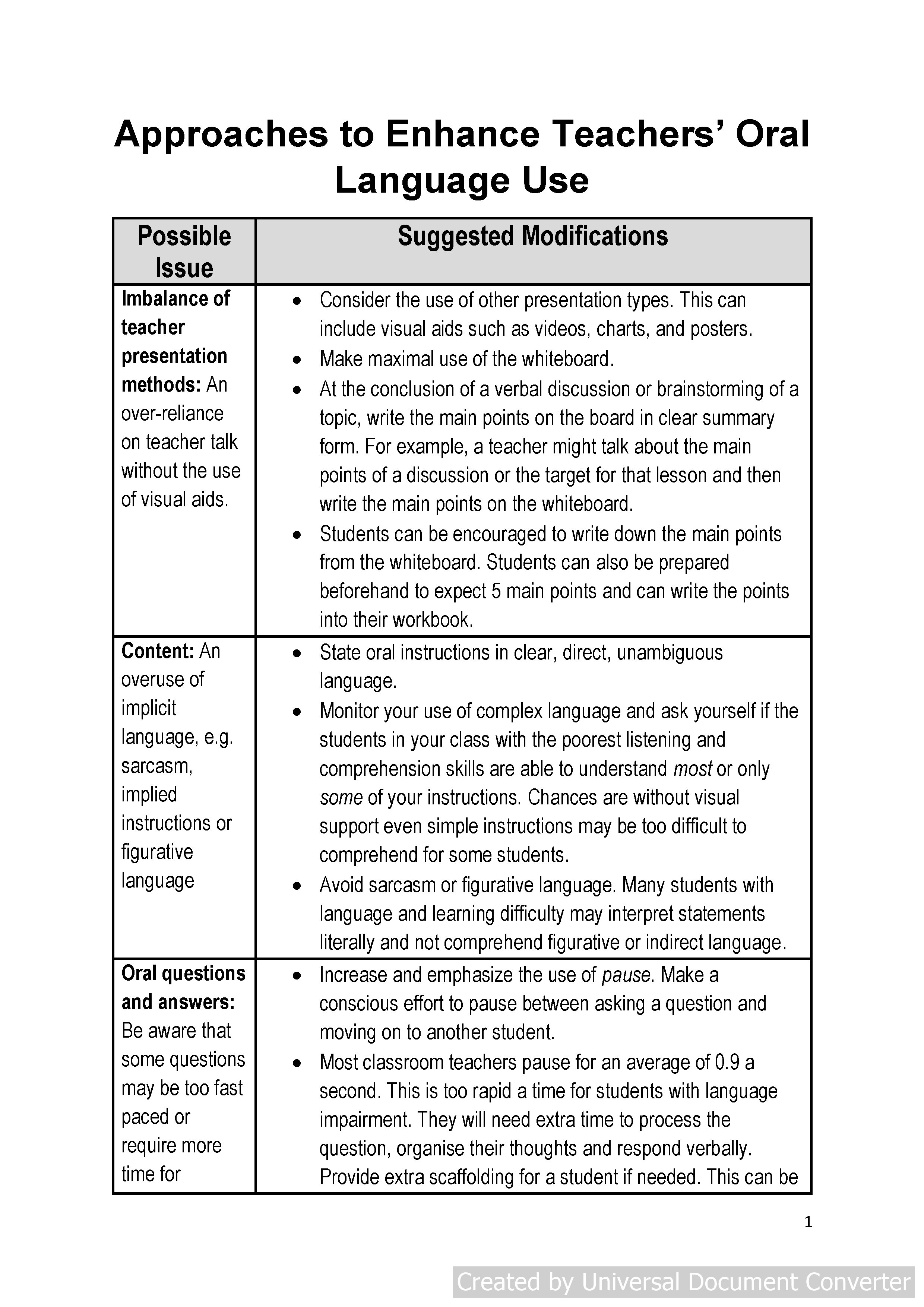Classroom Oral Language
Classroom Oral Language: The teacher talk and classroom oral language strategies and tips to be found on this page are a result of being in many classrooms over the years and having the opportunity to observe many talented and creative classroom teachers engage students in the classroom.
The classroom oral language techniques on this page are for secondary teachers in the main but can be applied also to middle school classrooms.

Image: photography by Felicia Buitenwerf, sourced from Unsplash
Classroom Oral Language - Teacher Approaches
Possible Issue - Imbalance of teacher presentation methods: An over-reliance on teacher talk without the use of visual aids.
Suggested Modifications
- Consider the use of other presentation types. This can include visual aids such as videos, charts, and posters.
- Make maximal use of the whiteboard.
- At the conclusion of a verbal discussion or brainstorming of a topic, write the main points on the board in clear summary form. For example, a teacher might talk about the main points of a discussion or the target for that lesson and then write the main points on the whiteboard.
- Students can be encouraged to write down the main points from the whiteboard. Students can also be prepared beforehand to expect 5 main points and can write the points into their workbook.
Possible Issue - An overuse of implicit language, e.g. sarcasm, implied instructions or figurative language.
Suggested Modifications
- State oral instructions in clear, direct, unambiguous language to enhance classroom oral language.
- Monitor your use of complex language and ask yourself if the students in your class with the poorest listening and comprehension skills are able to understand most or only some of your instructions. Chances are without visual support even simple instructions may be too difficult to comprehend for some students.
- Avoid sarcasm or figurative language. Many students with language and learning difficulty may interpret statements literally and not comprehend figurative or indirect language.

Image: photography by Taylor Wilcox, sourced from Unsplash
Possible Issue - Oral questions and answers: Be aware that some questions may be too fast paced or require more time for students with language disorder to respond.
Suggested Modifications
- Increase and emphasize the use of pause. Make a conscious effort to pause between asking a question and moving on to another student.
- Most classroom teachers pause for an average of 0.9 a second. This is too rapid a time for students with language impairment. They will need extra time to process the question, organize their thoughts and respond verbally. Provide extra scaffolding for a student if needed. This can be achieved by either rephrasing a question or writing a particular question on a whiteboard.
- Crucial: practice and be mindful of pausing for 3-4 seconds before moving to the next student or the next question. This is a great technique for engaging students’ interest and giving students time for processing.
- You can hold up your hand and count the 5 seconds. No students are allowed to call out or interrupt during those 5 seconds. Students can raise their hands once you give the go ahead. For students with the ability to answer questions but may be too shy to answer, discuss with students in private a subtle sign they can give in order to be selected for a question.
- Other scaffolding techniques: Request a single word response from a student instead of a sentence. Present a choice of 2 possible responses, ‘Is it this or is it that?’ Always praise the attempt, even if incorrect. Use a cloze procedure, for instance provide a student with the beginning of a sentence and prompt the student to complete the sentence, ‘To Kill a Mockingbird is set in the American Southern State of A ….”
Possible Issue: Sequencing: Information is not presented in a clearly sequenced manner.
Suggested Modifications
- Maximal use of the whiteboard is a critical component of sequencing key information. Consider having the lesson carefully signposted for yourself before the lesson starts and have specific time spent on a section. You may even write the length of time to be spent on a theme or module on the whiteboard (5 mins) etc.
- Students with language impairment, in terms of information covered in a lesson, need to know where they have just been, where they currently are and how much time they will need to be working on a particular topic and what is coming next. This can be achieved most efficiently by having the sequence of the activities clearly written on the whiteboard and consistently returning to the topics covered. Summarizing (discussed later) helps to reinforce a student’s orientation in a lesson.
- Consider also numbering the activities from 1-3, 1-5 or 1-10 or whatever the case may be. The numbered sequence presents a strong visual reinforcement of the activities to be covered in a given lesson.
- Consider using the whiteboard in a strategic fashion. This includes splitting the whiteboard in half or even quarters. One section can be devoted to the sequence you intend to use, for instance a sequence marked 1-5, other sections can be used to focus on the word or words of the day, while another specific and pre-arranged section of the whiteboard can be used for random ideas and spontaneous written expression if you wish to expand upon a point.
- Always use markers that feature strong and bold colours, such as blacks, blues or browns. Consider colour coding for specific points. Tired old markers with very light colours are difficult or impossible to be read from even a short distance.
- Don’t use cursive when writing main points. Keep the letters simple and clear, in script form preferably.
- Summarize: Summarize what you have covered for the lesson at the conclusion of the lesson. You can also restate the summarized points from the completed lesson at the beginning of the next lesson to reinforce the points previously learnt.
- Also consider summarizing the main 5 points of your lesson during the course of the lesson. So, for instance, first summarize point 1. Once point 1 is concluded, then move onto point 2. The summary only needs to be a short statement, such as, ‘Okay we’ve learnt so far that a proper noun has capital letters,’ or you could summarize with a cloze question, ‘Okay we’ve learnt so far that a proper noun has what…?’
Classroom Oral Language - Download
Some of the information available on this page was sourced from the LINK-S program. LINK-S is an evidence-based approach for speech pathologists and teachers to collaboratively support secondary school students with language difficulties. Click on the link to learn more about classroom oral language.
References
Starling, J. (2015) The Link-S program,
Starling, J., Munro, N., Togher, L., & Arciuli, J. (2012). Training secondary school teachers in instructional language modification techniques to support adolscents with language impairment: A randomised controlled trial. Language, Speech and Hearing Services in Schools, 43, 474-495.
Updated 01/10/2020

